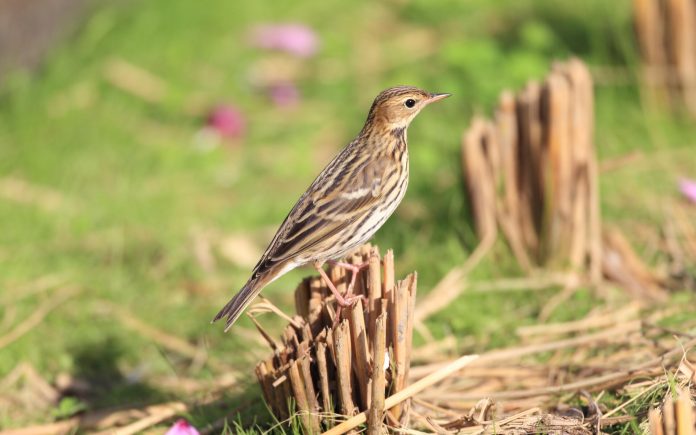The size of Pechora Pipit is (Anthus gustavi) 14 cm in length. It is found in the extreme northeast of our region only. This is a beautiful small, heavily streaked, and unusually skulking pipit.
The most striking features of Pechora are its warm brown upperparts, contrasting with white underparts, very heavily streaked appearance with white mantle ‘braces’ (latter feature often quoted as diagnostic, but shared by Red-throated and regularly indicated in Meadow), mainly pinkish bill, and prominent wing bars.

Most easily confused with First-winter Red-throated (or many adult females birds lacking pinkish on throat etc.) but potentially so with other small pipits; call important. It is well compared with Meadow, which is slightly plumper and has a somewhat stouter bill, further thickly striped underparts, and upperparts (with important whitish mantle stripes), streaked rump and upper tail coverts, brighter whitish lower underparts showing stronger contrast with upperparts.
Moreover, the plainer face with the more prominent dark eye; is eminent from the tree by thick striping on flanks, plainer ear-coverts, more prominent dark eye, pale mantle stripes, and streaked rump and upper tail coverts.
Many of these features are shared by the Red-throated Pipit, which is the main pitfall species. First-winter (or occasional adult) Red-throated with warm buff or whitish instead of reddish or pinkish on the throat, upper breast and supercilium are especially similar; apart from calls, the main distinguishing features to concentrate on are as follows.
Pechora Pipit is sleeker, with the slightly longer and heavier bill, narrower and longer tail, and, uniquely among pipits, three or more primary tips noticeable beyond tertials on the folded wing (primary tips cloaked in Red-throated, but a slight projection of primaries in Tree and Meadow; beware molting individuals). The common coloration of the upper parts is a richer, warmer brown, almost reddish-brown when fresh (upper parts look more grayish-brown or olive-brown in Red-throated), and streaking even blacker.
The white ‘braces’ on the mantle are longer, whiter, and more outstanding (but can be striking on Red-throated, too), and the two prominent white wing bars are especially striking (bars narrower and buffer on Red-throated), so upperparts appear even more contrastingly patterned; outer tail feathers duller, less pure white.
The crown is more heavily streaked, supercilium usually weaker, malar stripe weaker, rear ear-coverts finely streaked (virtually plain in Red-throated), and has a dark loral line that breaks pale eye-ring (a feature lacking in Red-throated, but beware effects of shadow which can sometimes make it seem as if dark loral line present); bill is pinkish on the lower mandible and cutting edge of the upper mandible (these areas usually yellowish in Red-throated, although occasionally pinkish).
The underparts are whiter with contrasting buff tones on the breast when fresh (underparts more uniformly buff-washed on Red-throated when fresh), although can be rather uniform whitish when worn; central lower underparts are unstreaked white (more extensively clean than in Red-throated); legs pinker, and ‘thighs’ darker than belly (uniform with belly on Red-throated). Habitually shows a prominent dark patch at the base of the neck, where are dark streaking coalesces, but this is equaled by some 1st-winter Red-throated.
Much more skulking than most other small pipits, tending to feed amongst rank vegetation (or crops during migration), so ample views can be hard to obtain; walks stealthily and sometimes pumps tail like Tree Pipit and Olive-backed Pipits. Although calls are luckily very distinctive, birds often frustratingly silent; flush with reluctance, almost underfoot, flying off and climbing with hesitant bounds like a small Tree Pipit.
When worn, plumage is duller, and less warm, and all streaks are more prominent and closer (owing to the wear of browner feather edges). Juvenile resembles fresh adult, but underpart streaking less defined and extends onto central belly and throat; soon becomes indistinguishable from a fresh adult.

Pechora Pipit call is distinguishing, but often flushes silently (unusual for a pipit); may give a low, short, soft ‘pit’, sometimes repeated two to three times, a dry ‘pwit’, slightly stronger than the previous call, or a hard, emphatic ‘tsip-tsip-tsip’, each note clearly separated and somewhat recalling flight call of Gray Wagtail.
Pechora Pipit’s song is distinctive and includes long trilled, rather scratchy, mechanical, buzzing phrases followed by a guttural warble, given in prolonged lark-like hovering song flight. Pechora Pipit is a local and uncommon, winter in the Philippines, Borneo, Sulawesi, and Lesser Sundas.
The bird breeds in areas of scrub (particularly willow) and tall grasses or sedges in drier sections of wet tundra; in winter quarters favors rainforest. Vagrants have occurred in low crops, stubble, and rank grass.







